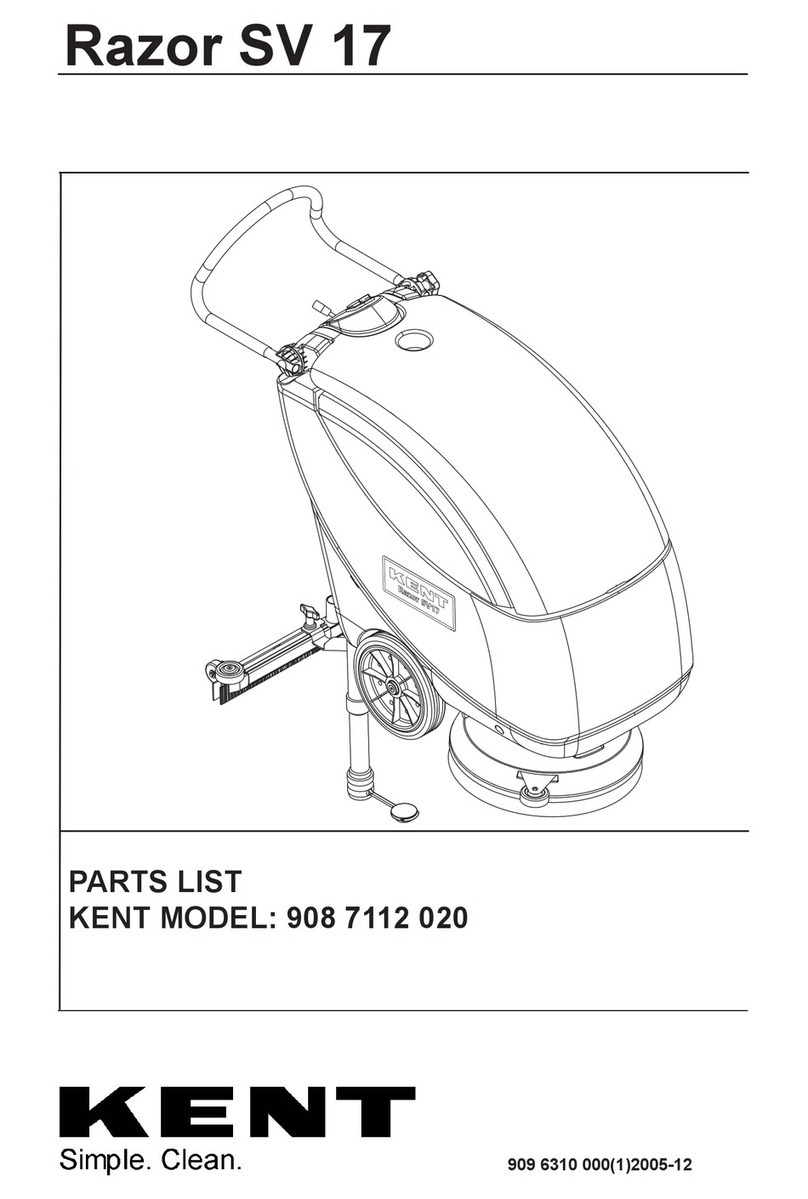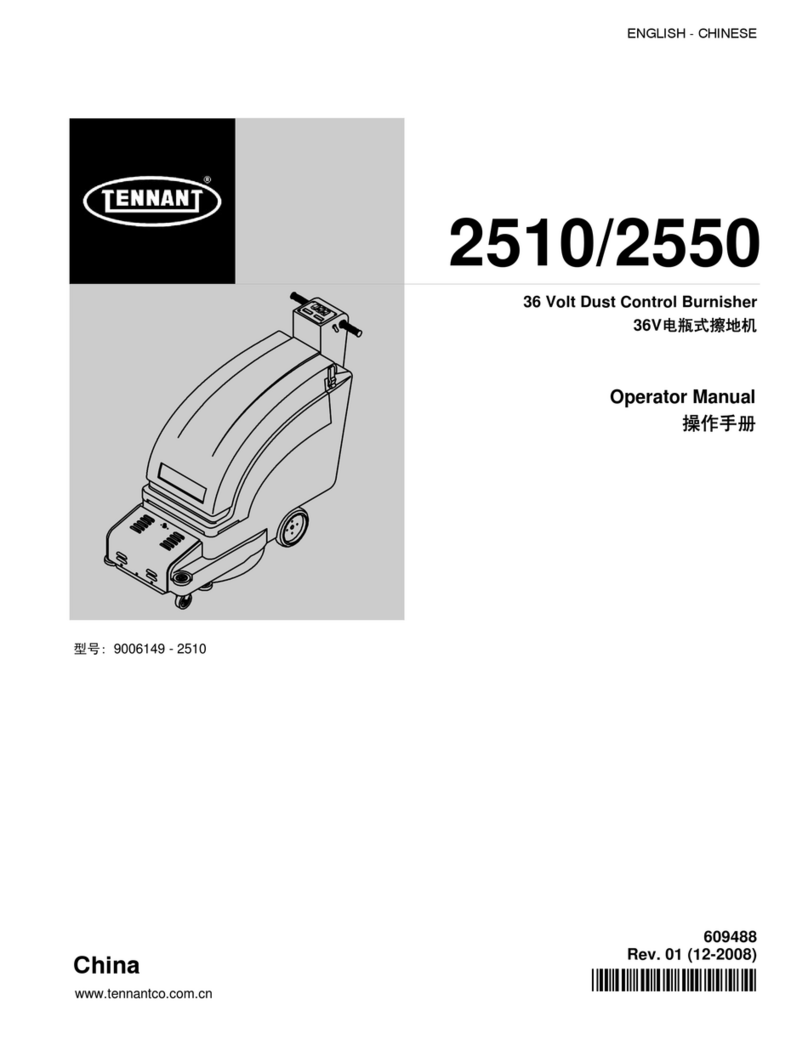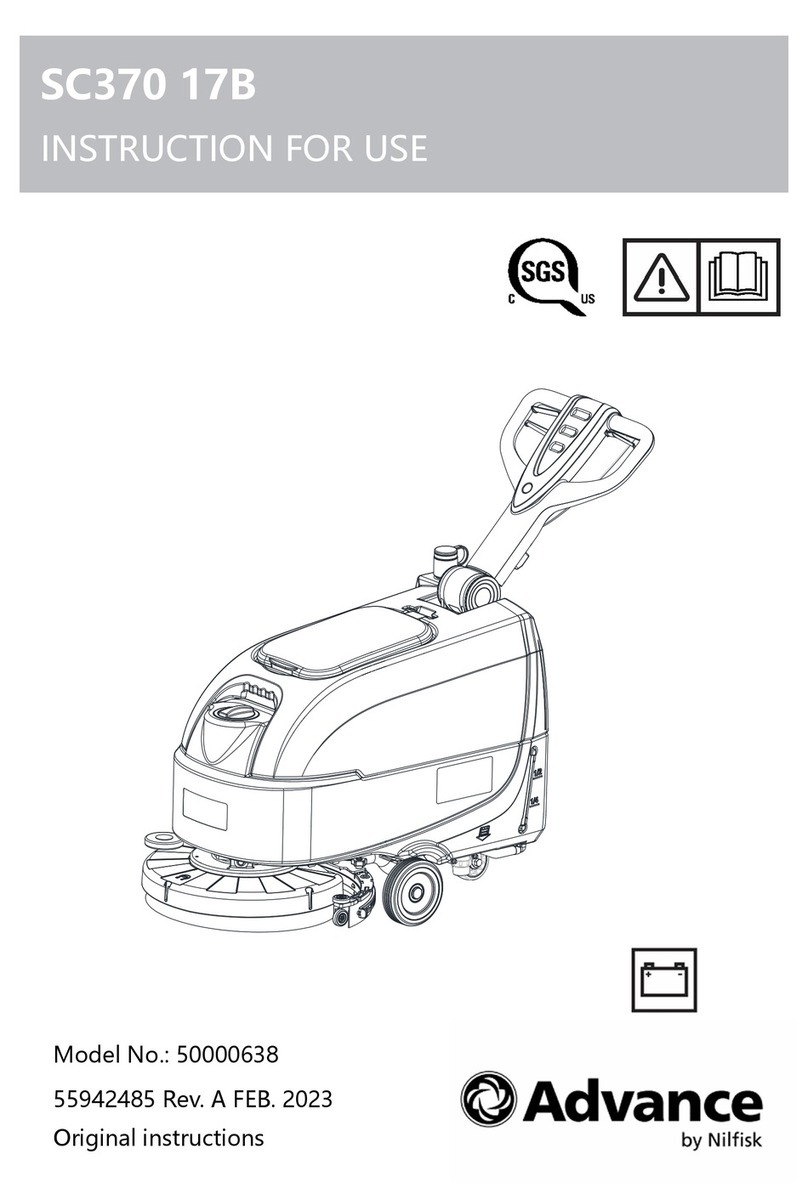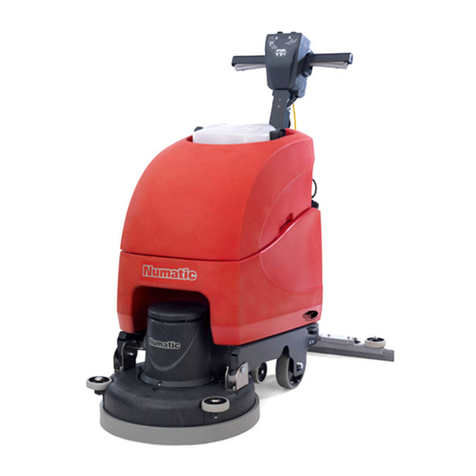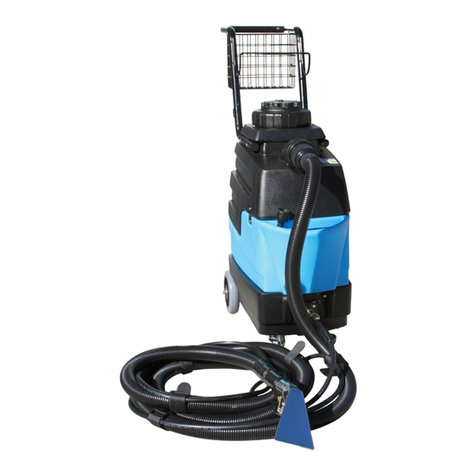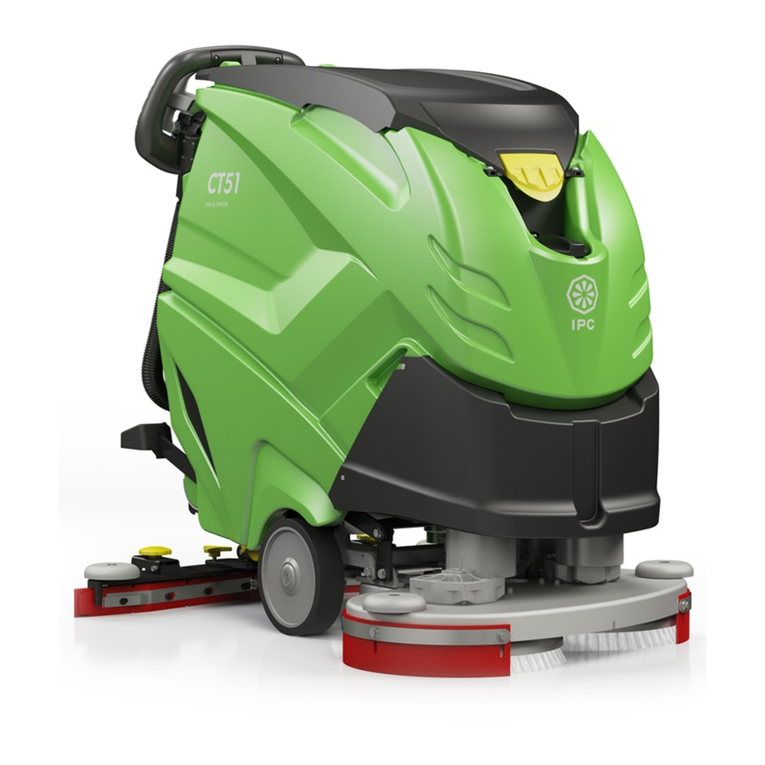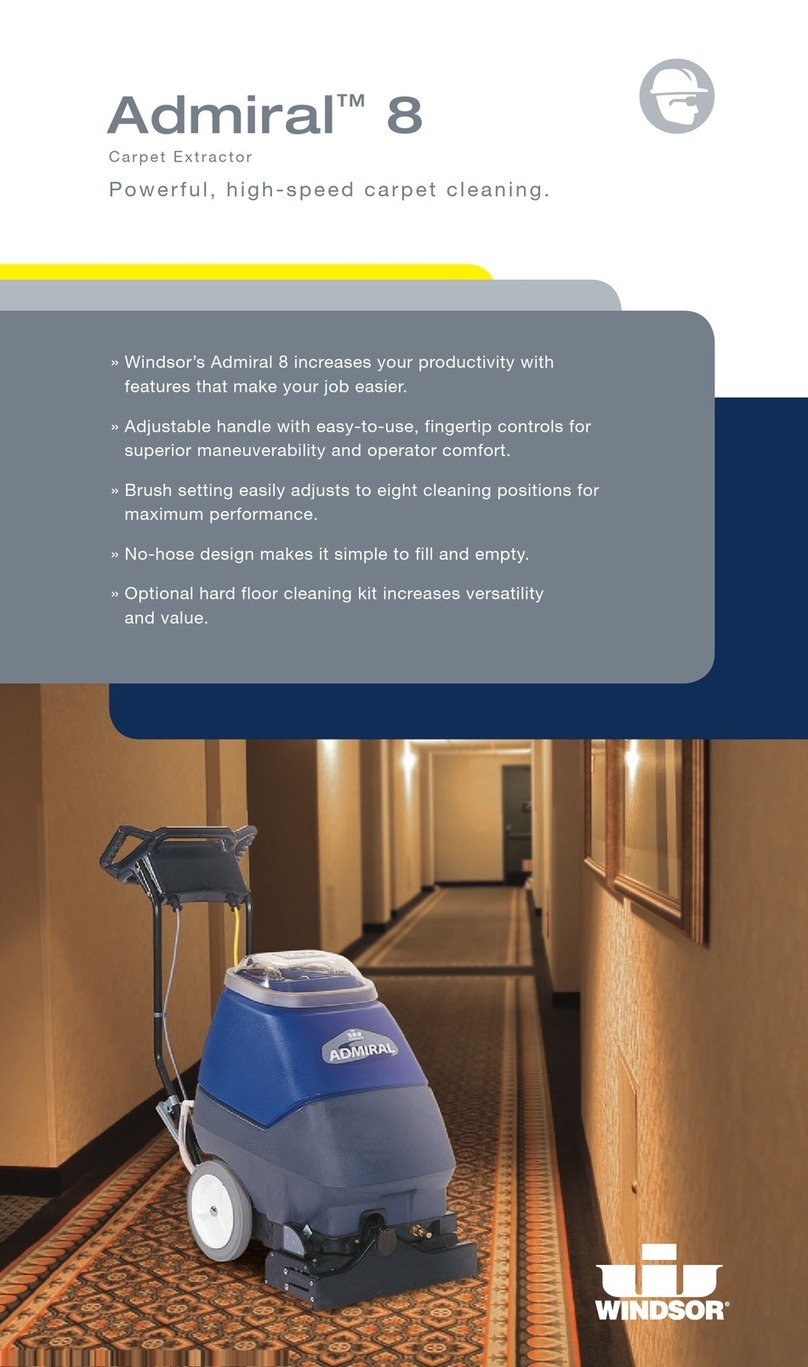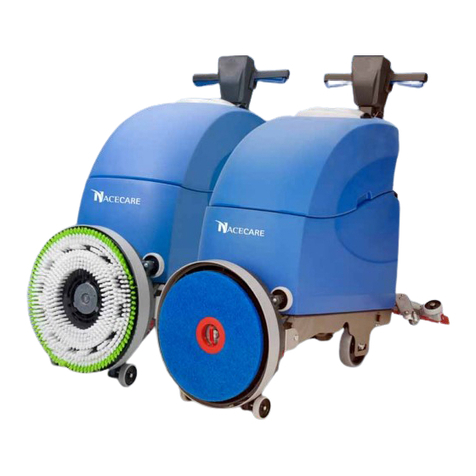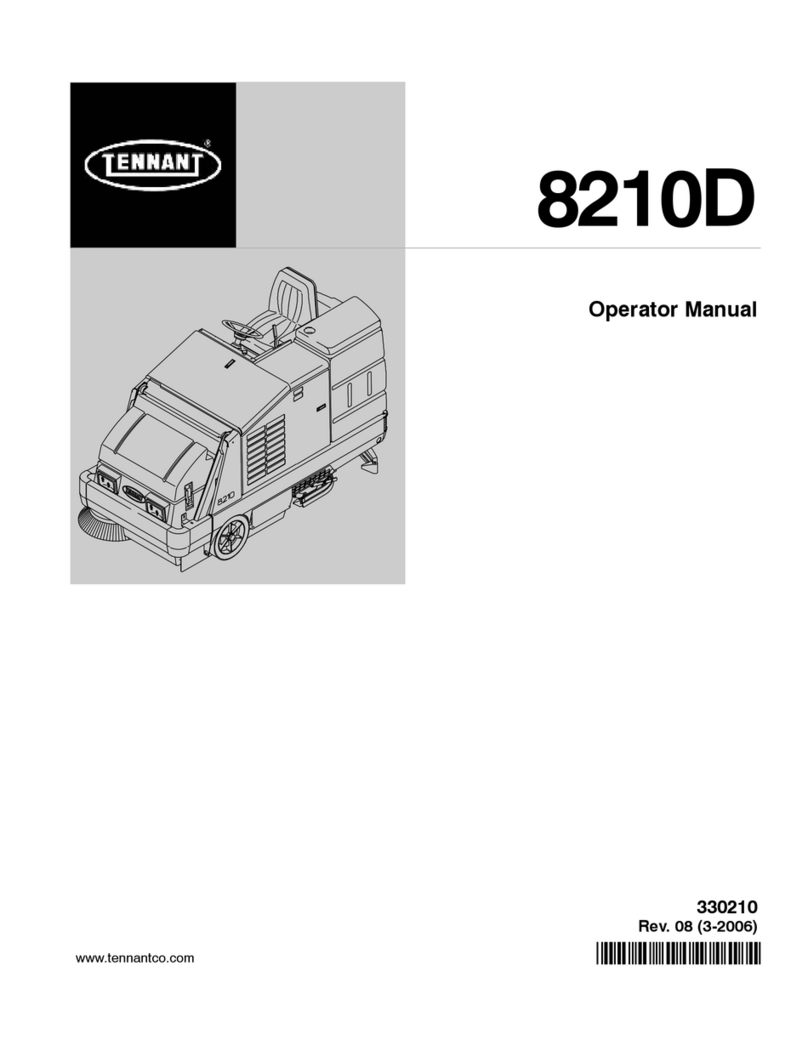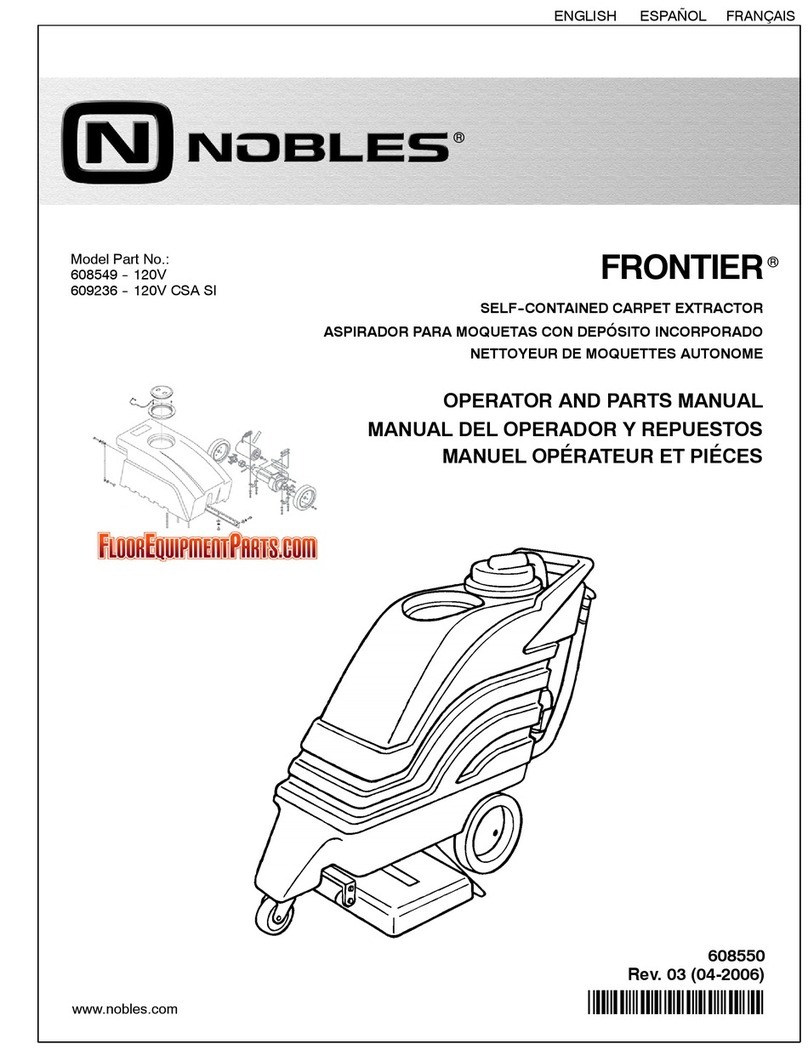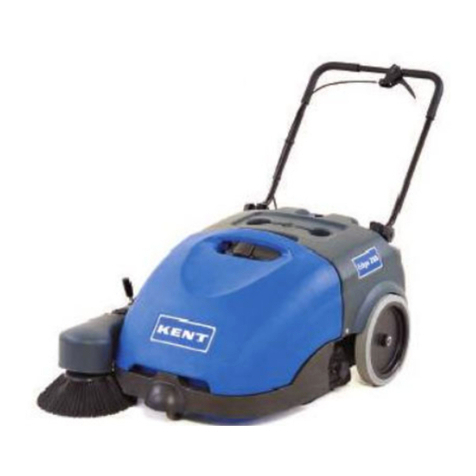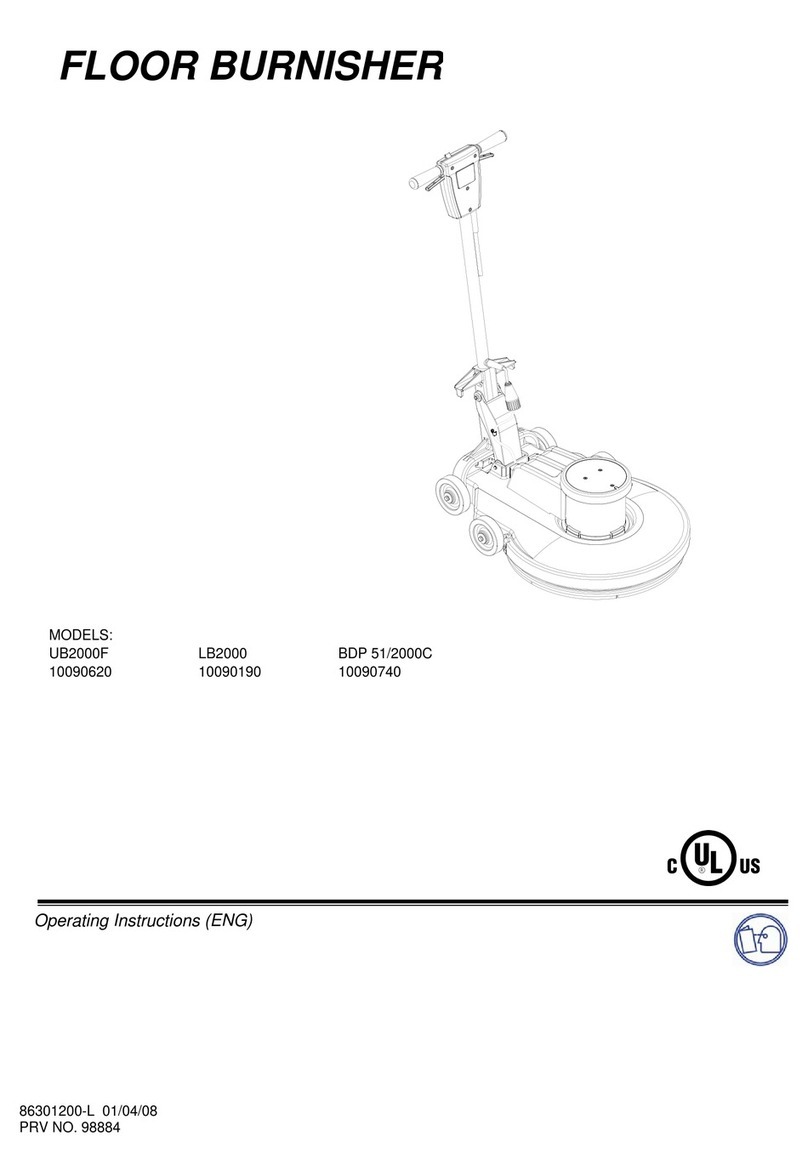Kent Euroclean Razor SV 17 User manual

Razor SV17
INSTRUCTIONS FOR USE
KENT model:
908 7112 020
INSTRUCTIONS D’UTILISATION
Modèle KENT:
908 7112 020
INSTRUCCIONES DE USO
Modelo KENT:
908 7112 020
INSTRUÇÕES DE USO
Modelo KENT:
908 7112 020
909 6309 000(1)2006-01

909 6309 000(1)2006-01
10
9
7
5 9 12 71
2
1
6
6
43
14
13
32
30
31
6
3
19 2
17
16
25
26
18
24
23 10 9
813
14
15
11
15
12
22
7
4
5b
5a
1
21 27
28
29
23a 23b
2
3
4
15
6
D
S311240
E
S311226
F
S311227
B
S311238
C
S311239

INSTRUCTIONS FOR USE
Razor SV17 —909 6309 000(1)2006-01 1
INTRODUCTION ................................................................................................................................... 2
MANUAL PURPOSE AND CONTENTS ........................................................................................................... 2
TARGET ........................................................................................................................................................... 2
HOW TO KEEP THIS MANUAL ....................................................................................................................... 2
IDENTIFICATION DATA ................................................................................................................................... 2
OTHER REFERENCE MANUALS .................................................................................................................... 2
SPARE PARTS AND MAINTENANCE ............................................................................................................. 2
CHANGES AND IMPROVEMENTS ................................................................................................................. 2
SAFETY ................................................................................................................................................. 3
SYMBOLS ......................................................................................................................................................... 3
GENERAL INSTRUCTIONS ............................................................................................................................. 3
UNPACKING ......................................................................................................................................... 4
MACHINE DESCRIPTION ..................................................................................................................... 5
OPERATION CAPABILITIES ............................................................................................................................ 5
CONVENTIONS ................................................................................................................................................ 5
DESCRIPTION ................................................................................................................................................. 5
TECHNICAL DATA ........................................................................................................................................... 6
ELECTRICAL FUSES ....................................................................................................................................... 6
ACCESSORIES/OPTIONS ............................................................................................................................... 6
USE ........................................................................................................................................................ 7
BATTERY CHECK/SETTING ON A NEW MACHINE ...................................................................................... 7
(WET OR GEL) BATTERY SETTING, INSTALLATION AND CHARGING ...................................................... 7
BEFORE START-UP ........................................................................................................................................ 8
MACHINE START AND STOP ......................................................................................................................... 8
MACHINE OPERATION (SCRUBBING/DRYING) ...........................................................................................9
MACHINE TRANSPORT/PARKING ................................................................................................................. 9
TANK EMPTYING ............................................................................................................................................. 9
AFTER USING THE MACHINE ...................................................................................................................... 10
RECOVERY WATER TANK REMOVAL ......................................................................................................... 10
MACHINE LONG INACTIVITY ....................................................................................................................... 10
FIRST PERIOD OF USE ................................................................................................................................ 10
MAINTENANCE .................................................................................................................................. 10
SCHEDULED MAINTENANCE TABLE .......................................................................................................... 11
SQUEEGEE CLEANING ................................................................................................................................ 11
SQUEEGEE BLADE CHECK AND REPLACEMENT ..................................................................................... 11
BRUSH CLEANING ........................................................................................................................................ 12
TANK AND VACUUM GRID CLEANING ........................................................................................................ 12
SOLUTION FILTER CLEANING ..................................................................................................................... 12
MACHINE SPEED ADJUSTMENT ................................................................................................................. 12
CHARGING THE BATTERIES ....................................................................................................................... 13
FUSE CHECK/REPLACEMENT ..................................................................................................................... 13
TROUBLESHOOTING ........................................................................................................................ 14
SCRAPPING ........................................................................................................................................ 14

INSTRUCTIONS FOR USE
2Razor SV17 —909 6309 000(1)2006-01
INTRODUCTION
MANUAL PURPOSE AND CONTENTS
The purpose of this Manual is to provide the customer with all
necessary information to use the machine properly in a safe
an autonomous way. It contains information about technical
data, operation, machine inactivity, maintenance, spare parts
and safety conditions.
Before carrying out any procedure on the machine, the
operators and qualified technicians must read this Manual
carefully. Contact an authorized KENT Service Center in case
of doubts concerning the interpretation of the instructions and
for any further information.
TARGET
This Manual is intended for operators and technicians
qualified to perform the machine maintenance.
The operators must not carry out operations reserved for
qualified technicians. KENT will not be answerable for
damages coming from the non-observance of this prohibition.
HOW TO KEEP THIS MANUAL
The Instructions for Use Manual must be kept near the
machine, inside an adequate case, away from liquids and
other substances that can cause damage to it.
IDENTIFICATION DATA
The machine serial number and model are shown on the label
and can be read from the outside (1, Fig. C).
The machine model year is shown after the Date Code on the
serial plate (A06 means January 2006).
This information is useful when requiring machine spare
parts. Use the following table to write down the machine
identification data for any further reference.
OTHER REFERENCE MANUALS
– Electronic Battery Charger Manual (if equipped), which
is to be considered as integral part of this Manual.
– Spare Parts List, supplied with the machine.
– Service Manual (that can be consulted at KENT Service
Centers).
SPARE PARTS AND MAINTENANCE
All necessary operating, maintenance and repair procedures
must be carried out by qualified personnel or by KENT
Service Centers. Only original spare parts and accessories
must be used.
Call KENT for service or to order spare parts and
accessories, specifying the machine model and serial
number.
CHANGES AND IMPROVEMENTS
KENT constantly improves its products and reserves the right
to make changes and improvements at its discretion without
being obliged to apply such benefits to the machines
previously sold.
Any change and/or addition of accessories must be approved
and performed by KENT.
MACHINE model ...........................................................
MACHINE serial number ...............................................

INSTRUCTIONS FOR USE
Razor SV17 —909 6309 000(1)2006-01 3
SAFETY
The following symbols indicate potentially dangerous
situations. Always read this information carefully and take all
necessary precautions to safeguard people and property.
The operator's cooperation is essential in order to prevent
injury. No accident prevention program is effective without the
total cooperation of the person responsible for the machine
operation. Most of the accidents that may occur in a factory,
while working or moving around, are caused by failure to
comply with the simplest rules for exercising prudence. A
careful and prudent operator is the best guarantee against
accidents and is essential for successful completion of any
prevention program.
SYMBOLS
GENERAL INSTRUCTIONS
Specific warnings and cautions to inform about potential
damages to people and machine are shown below.
– Disconnect the batteries before performing any
maintenance/repair procedure.
– This machine must be used by properly trained and
authorized personnel only. Children or disabled people
cannot use this machine.
– When using lead (WET) batteries, keep sparks, flames
and smoking materials away from the batteries. During
the normal operation explosive gases are released.
– Do not wear jewels when working near electrical
components.
– Do not operate the machine near toxic, dangerous,
inflammable and/or explosive powders, liquids or
vapours.
– When using lead (WET) batteries, battery charging
produces highly explosive hydrogen gas. During battery
charging, remove the recovery water tank and perform
this operation in well-ventilated areas and away from
naked flames.
– Carefully read all the instructions before carrying out any
maintenance/repair procedure.
– Before connecting the battery charger to the electrical
mains, be sure that frequency and voltage indicated in
the related Manual correspond to the mains voltage.
– To reduce the risk of fire, electric shock, or injury, do not
leave the machine unattended when it is plugged in.
Unplug the machine from the outlet when not in use and
before servicing.
– To avoid electric shock, do not expose to rain. Store the
machine indoors.
– Do not allow to be used as a toy. Close attention is
necessary when used near children.
– Use only as described in this Manual. Use only KENT's
recommended accessories.
– Do not use with damaged power supply cable or plug. If
the machine is not working as it should, has been
damaged, left outdoors or dropped into water, return it to
the Service Center.
– If the supply cable or the plug is worn or damaged, it
needs to be replaced at the Service Center.
– Do not pull or carry the machine by the supply cable;
never use the power supply cable as a handle. Do not
close a door on the supply cable, or pull the supply cable
around sharp edges or corners. Do not run the machine
on the supply cable. Keep the supply cable away from
heated surfaces.
– When using lead (WET) batteries, don't smoke while
charging the batteries.
– Take all necessary precautions to prevent hair, jewels
and loose dresses from being caught by the machine
moving and vacuuming devices.
– Do not work under the lifted machine without supporting
it with safety stands.
DANGER!
It indicates a dangerous situation with risk of
death for the operator.
WARNING!
It indicates a potential risk of injury for people.
CAUTION!
It indicates a caution or a remark related to
important or useful functions. Pay particular
attention to the paragraphs marked by this
symbol.
NOTE
It indicates the necessity to refer to the
Instructions for Use Manual before performing
any operation.
DANGER!
WARNING!

INSTRUCTIONS FOR USE
4Razor SV17 —909 6309 000(1)2006-01
– Do not leave the machine unattended without being sure
that the machine cannot move independently.
– Do not use the machine on slopes with a gradient
exceeding the specifications.
– Do not wash the machine with direct or pressurized
water jets, or with corrosive substances.
– Do not use the machine in particularly dusty areas.
– While using this machine, take care not to cause
damage to people.
– Do not put any can containing fluids on the machine.
– The storage temperature must be between +32°F and
+104°F (0°C and +40°C).
– The machine operating temperature must be between
+32°F and +104°F (0°C and +40°C).
– The humidity must be between 30% and 95%.
– Always protect the machine against the sun, rain and
bad weather, both under operation and inactivity
condition.
– Do not use the machine as a means of transport.
– Do not allow the brush to operate while the machine is
stationary to avoid damaging the floor.
– In case of fire, possibly use a powder fire extinguisher,
not a water one.
– Do not bump into shelves or scaffoldings, particularly
where there is a risk of falling objects.
– Do not tamper with the machine safety guards and follow
the ordinary maintenance instructions scrupulously.
– Do not remove or modify the plates affixed to the
machine.
– In case of machine malfunctions, ensure that these are
not caused by a lack of maintenance. Otherwise,
request assistance from the authorized personnel or
from an authorized Service Center.
– If parts must be replaced, require ORIGINAL spare parts
from a Dealer or Authorized Retailer.
– To ensure the proper and safe operation of the machine,
have the scheduled maintenance, detailed in the
relevant chapter of this Manual, performed by the
authorized personnel or an authorized Service Center.
– The machine must be disposed of properly, because of
the presence of toxic-harmful materials (batteries, etc.),
which are subject to standards that require disposal in
special centers (see Scrapping chapter).
– If the machine is used according to the instructions, the
vibrations do not cause dangerous situations. The
machine vibration level is less than 98.42 in/s2(2.5 m/s2)
(98/37/EEC - EN 1033/1995).
– Do not allow any object to enter into the openings. Do
not use the machine if the openings are clogged. Always
keep the openings free from dust, hairs and any other
foreign material which could reduce the air flow.
– This machine cannot be used on roads or public streets.
– Pay attention during the machine transfers when
temperature is below freezing point. The water in the
recovery tank or in the hoses could freeze and seriously
damage the machine.
– Use only brushes and pads supplied with the machine or
specified in this Manual. Using other brushes or pads
could reduce safety.
– When lead (WET) batteries are installed on the machine,
do not tilt the machine more than 30° from the horizontal
plane to prevent the highly corrosive acid from leaking
out of the batteries. If the machine must be tilted to
perform any maintenance operation, remove the
batteries.
UNPACKING
To unpack the machine carefully follow the instructions on the
packing.
When the machine is delivered, check that the packing and
the machine were not damaged during transportation. In case
of visible damages, keep the packing and have it checked by
the Carrier that delivered it. Call the Carrier immediately to fill
in a damage claim.
Please check that the following items have been supplied with
the machine:
1. Technical documents:
– Scrubber-dryer Instructions for Use Manual
– Electronic battery charger manual (if equipped).
– Scrubber-dryer Spare Parts List
2. No.1 40A lamellar fuse
3. No.2 battery panels
4. (Only for machine supplied without batteries)
– No.1 battery jump cable
– No.4 battery terminal caps

INSTRUCTIONS FOR USE
Razor SV17 —909 6309 000(1)2006-01 5
MACHINE DESCRIPTION
OPERATION CAPABILITIES
This scrubber-dryer is used to clean (scrubbing and drying)
smooth and solid floors, in civil or industrial environment,
under safe operation conditions by a qualified operator.
The scrubber-dryer cannot be used for moquette and carpet
cleaning.
CONVENTIONS
Forward, backward, front, rear, left or right are intended with
reference to the operator’s position, that is to say with the
hands on the handlebar (2, Fig. C).
DESCRIPTION
Control panel
(See Fig. B)
1. Control panel
2. Charged battery warning light (green)
3. Semi-discharged battery warning light (yellow)
4. Discharged battery warning light (red)
5. Brush/pad switch
6. Vacuum switch
Exterior rear view
(See Fig. C)
1. Serial number plate/technical data
2. Handlebar
3. Handlebar inclination adjusting knob
4. Solution flow control lever
5a. Solution flow control lever ECO position (water
"economy" usage, for a washing autonomy of 70-80
minutes).
5b. Maximum solution flow
5. Recovery water tank cover
6. Rear support wheel for transport/parking
7. Central wheels on fixed axle
8. Brush/pad
9. Brush/pad cover
10. Squeegee
11. Squeegee fixing handwheels
12. Front squeegee blade
13. Rear squeegee blade
14. Squeegee blade fixing springs
15. Recovery water drain hose
16. Recovery water drain hose bracket
17. Solution drain valve
18. Squeegee lifting/lowering lever
19. Solution filter
20. Battery charger-electrical mains connecting cable
(optional)
21. Squeegee vacuum hose
22. Transport/parking device
23a. Transport/parking device activated
23b. Transport/parking device deactivated
23. Transport/parking device positioning pin
24. Electrical component box
25. Battery charger (optional)
26. Battery charger warning lights (optional)
27. Battery installation diagram
28. Battery connector (models without on-board battery
charger)
29. Brush/pad support (activated)
30. Recovery water tank
31. Solution tank
Under-tank front view
(See Fig. J)
1. Recovery water tank cover (open)
2. Recovery water tank cover gasket
3. Brush/pad support (activated)
4. Recovery water tank
5. Solution tank
6. Vacuum grid with automatic shut-off float
7. Recovery water drain hole
8. Vacuum system motor
9. Brush/pad motor
10. Batteries
11. Battery installation diagram
12. Cover with brush/pad-holder coupling pin
13. Machine speed adjusting screw
14. Brush
15. Pad-holder
16. Pad
17. Screw
18. Compensation hole
19. Cover stand (applied)

INSTRUCTIONS FOR USE
6Razor SV17 —909 6309 000(1)2006-01
TECHNICAL DATA Wiring diagram
(See Fig. L)
CH1: Battery charger
C1: Battery charger connector
EB1: Electronic board (CF BA430)
EB2: Electronic board led (CF BALED)
ES1: Brush/pad switch
ES2: Vacuum switch
ES3: Battery charger relay
EV1: Water solenoid valve
F1: Brush fuse (40A)
F2: Vacuum fuse (40A)
F3: Solenoid valve and electronic board fuse (5A)
IS1: Negative insulator
M1: Brush/pad motor
M2: Vacuum system motor
SW1: Brush/pad switch
SW2: Vacuum switch
Colour code
BK: Black
BU: Blue
BN: Brown
GN: Green
GY: Grey
OG: Orange
PK: Pink
RD: Red
VT: Violet
WH: White
YE: Yellow
ELECTRICAL FUSES
The following fuses are located under the cover (1, Fig. I):
– Brush (40A): (2, Fig. I)
– Vacuum (40A): (3, Fig. I)
– Solenoid valve and electronic board (5A): (4, Fig. I)
ACCESSORIES/OPTIONS
In addition to the standard components, the machine can be
equipped with the following accessories/options, according
the machine specific use:
– Brushes/pads of different materials;
– Electronic battery charger.
For further information concerning the above-mentioned
optional accessories, contact an authorized Retailer.
General Values
Cleaning width 17.0 in (430 mm)
Machine width (without squeegee) 22.4 in (570 mm)
Minimum machine length with adjustable
handlebar 36.6 in (930 mm)
Minimum machine height with adjustable
handlebar
40.2/44.7 in
(1,020/1,135 mm)
Squeegee width 28.3 in (720 mm)
Machine weight (with batteries, battery
charger and brush) 233.70 lbs (106 Kg)
Central (fixed axle) wheel diameter 9.8 in (250 mm)
Brush/pad diameter 17.0 in (430 mm)
Wheel pressure on the ground <0.5 N/mm2
Brush/pad pressure on the ground (with full
tank) 50,6 lbs (23 Kg)
Battery compartment size (length x width x
height)
13.8 x 13.8 x 10.2 in
(350 x 350 x 260 mm)
Performance Values
Vacuum 41.5 in H2O
(1,055 mm H2O)
Sound pressure level 67 dB (A)
Vacuum system motor power 330 W
Brush/pad motor power 520 W
Battery voltage 24 V
Standard batteries 12 V, 50 Ah
Clean water tank capacity 8 gal (31 liters)
Recovery water tank capacity 7.9 gal (30 liters)

INSTRUCTIONS FOR USE
Razor SV17 —909 6309 000(1)2006-01 7
USE
While reading this Manual, the operator must pay particular
attention to the symbols shown on the plates.
Do not cover these plates for any reason and immediately
replace them if damaged.
BATTERY CHECK/SETTING ON A NEW
MACHINE
The machine requires two 12V batteries, connected
according to the diagram (28, Fig. C).
The machine can be supplied in one of the following modes:
a) GEL batteries already installed and ready to be
used.
– Start the machine by pressing the brush/pad and
vacuum switches (5 and 6, Fig. B). If the green
warning light (2, Fig. B) turns on, the batteries are
charged.
If the yellow or red warning light (3 or 4, Fig. B) turns
on, it is necessary to charge the batteries before
using the machine (see the procedure in the
Maintenance chapter).
(b) Without battery
– Buy appropriate batteries [See the Technical Data
paragraph and the diagram (28, Fig. C)].
For the battery choice and installation, apply to
qualified battery retailers.
– Perform setting for (WET) or (GEL) batteries, then
install the batteries on the machine and charge them,
according to the procedure shown in the next
paragraph.
(WET OR GEL) BATTERY SETTING,
INSTALLATION AND CHARGING
The electronic board of the machine is to be set according to
the type of batteries chosen, lead (WET) or gel (GEL).
Proceed as follows:
Machine setting
1. Ensure that the battery connector (29, Fig. C), if
equipped, is disconnected.
2. The machine factory setting is for GEL batteries; if
this setting corresponds to the type of batteries bought,
go to step 6. Otherwise, carry out steps 3, 4 and 5 too.
3. Remove the screws (5, Fig. I) and carefully pull out the
electrical component box cover (1).
4. Turn the microswitch (6, Fig. I) to WET position.
5. Reinstall the electrical component box cover (1, Fig. I)
and tighten the screws (5).
Battery installation
6. Disconnect the vacuum hose (22, Fig. C) from the
squeegee (11).
7. Disconnect the recovery water drain hose (16, Fig. C)
from the bracket (17).
8. Open the cover (6, Fig. C) and apply the cover stand (19,
Fig. J).
9. Grasp the recovery water tank (1, Fig. H) in the area (2)
and slightly raise it.
10. Disconnect the vacuum hose (3) from the tank, then
remove the tank (1) with the hoses (4) and (5).
11. Install the batteries on the machine according to the
diagram (28, Fig. C).
12. Reinstall the tank (1, Fig. H) by carrying out steps 6 to 10
in the reverse order.
Battery charging
13. Charge the batteries (see the relevant procedure in the
Maintenance chapter).
WARNING!
On some points of the machine there are some
adhesive plates indicating:
– DANGER
– WARNING
–CAUTION
–NOTE
WARNING!
The electric components of this machine can
be seriously damaged if batteries are either
installed or connected improperly. The
batteries must be installed by qualified
personnel only.
Check the batteries for damage before
installation.
Handle the batteries with great care.
Install the battery terminal caps supplied with
the machine.
WARNING!
Do not move the adjacent switch (7, Fig. I).

INSTRUCTIONS FOR USE
8Razor SV17 —909 6309 000(1)2006-01
BEFORE START-UP
Squeegee installation
1. Install the squeegee (11, Fig. C) and fix it by means of
the handwheels (12), then connect the vacuum hose
(22) to the squeegee.
Solution tank filling
2. Fill the solution tank (5, Fig. J) with a solution suitable for
the work to be carried out.
Do not fill the solution tank completely, leave few inches
from the edge.
Always follow the dilution instructions on the label of the
chemical product used to prepare the solution.
The solution temperature must not exceed 104°F
(40°C).
Brush or pad-holder installation
3. Insert the positioning pin (24, Fig. C) and deactivate the
transport/parking device (23b).
4. Lift the brush/pad cover (10, Fig. C) by prying the
handlebar (2).
5. Place the brush (14, Fig. J) or the pad-holder (15) under
the cover.
6. Lower the cover (10, Fig. C) by means of the handlebar
(2).
7. Hook the brush/pad-holder by pressing the brush/pad
switch (5, Fig. B) for a few seconds.
If the hooking operation is difficult, manually rotate the
brush/pad-holder counter-clockwise (Fig. K).
Adjustments
8. Using the knob (3, Fig. C), adjust the handlebar (2) to the
most comfortable position.
MACHINE START AND STOP
Machine start
1. Prepare the machine according to the procedure shown
in the previous paragraph.
2. Lower the squeegee (11, Fig. C) by means of the lever
(19).
3. Turn the solution flow control lever (4, Fig. C) to one of
the following positions, according to the type of cleaning
to be carried out:
–ECO system: When the lever (4) is in the “ECO”
position (5a), the machine works in a special
condition of programmed water "economy" usage;
as the water flow is set and constant, the machine
can work with a washing autonomy of 70-80 minutes
[0.08 gal/min (0.3 liters/min) average].
–Variable system: When the lever is turned to the left
(variable flow), it is possible to increase the capacity
up to 0.26 gal/min (1 liter/min).
During machine operation, it is not possible to close
completely the water flow to the brushes.
4. While keeping one hand on the handlebar (2, Fig. C),
start the machine by turning the brush/pad switch and
the vacuum switch (5 and 6, Fig. B) to "I".
Machine stop
5. Turn the brush/pad switch and the vacuum switch (5 and
6, Fig. B) to “0”.
6. Lift the squeegee by means of the lever (19, Fig. C).
7. Insert the positioning pin (24, Fig. C) and lift the
brush/pad by activating the transport/parking device
(23a).
CAUTION!
Use only low-foam and non-flammable liquid
detergents, intended for automatic scrubber
applications.
NOTE
Use either the brush (14, Fig. J) or the
pad-holder (15) according to the type of floor to
be cleaned. NOTE
If the green warning light (2, Fig. B) turns on,
the machine is ready to be used.
If the yellow or red warning light (3 or 4, Fig. B)
turns on, it is necessary to charge the batteries
(see the procedure in the Maintenance
chapter).

INSTRUCTIONS FOR USE
Razor SV17 —909 6309 000(1)2006-01 9
MACHINE OPERATION (SCRUBBING/DRYING)
1. Start the machine according to the procedure shown in
the previous paragraph.
2. While keeping both hands on the handlebar (2, Fig. C),
move the machine and start scrubbing/drying the floor.
3. If necessary, adjust the solution flow sent to the brushes
by turning the lever (4, Fig. C).
Battery discharge during operation
4. Until the green warning light (2, Fig. B) stays on, the
batteries allow the machine to operate normally.
When the green warning light (2) turns off and the yellow
(3) and red (4) warning lights turn on in sequence, it is
necessary to charge the batteries.
Machine speed adjustment
5. The machine speed varies according to the type of floor
to be cleaned and the choice of using the brush or the
pad.
If necessary, it is possible to adjust the machine speed
by following the relevant procedure in the Maintenance
chapter.
MACHINE TRANSPORT/PARKING
To transport/park the machine, proceed as follows.
1. Turn the brush/pad switch and the vacuum switch (5 and
6, Fig. B) to “0”.
2. Lift the squeegee by means of the lever (19, Fig. C).
3. Grasp the handlebar (2, Fig. C) and slightly lower it until
the rear wheel (7, Fig. C) comes into contact with the
floor (Fig. D). While holding the machine in this position,
push it to the transport/parking area.
4. After finishing the work, in order not to drag the
brush/pad on the floor and leave wet marks, remove the
brush/pad from the deck by using the release device (for
the procedure, see the After Using The Machine
paragraph), then place it on the support (3, Fig. J).
TANK EMPTYING
An automatic float shut-off system (6, Fig. J) stops the
vacuum system when the recovery water tank (4) is full.
The vacuum system deactivation is signalled by a sudden
increase in the vacuum system motor noise frequency.
When the recovery water tank (4, Fig. J) is full, empty it
according to the following procedure.
Recovery water tank emptying
1. Stop the machine by pressing the brush/pad and
vacuum switches (5 and 6, Fig. B).
2. Lift the squeegee by means of the lever (19, Fig. C).
3. Drive the machine to the appointed disposal area.
4. Insert the positioning pin (24, Fig. C) and lift the
brush/pad by activating the transport/parking device
(23a).
5. Empty the recovery water tank by means of the drain
hose (16, Fig. C).
Then, rinse the tank with clean water.
Solution tank emptying
6. Carry out steps 1 to 4.
7. Empty the solution tank by means of the drain valve (18,
Fig. C).
Then, rinse the tank with clean water.
CAUTION!
To avoid damaging the floor surface:
– Do not use the brush/pad without the
solution.
– When the machine is stopped, stop the
brush/pad by pressing the switch (5, Fig.
B).
CAUTION!
Before lifting the brush/pad, stop its rotation
by pressing the switch (5, Fig. B).
CAUTION!
Do not use the machine with discharged
batteries, to avoid damaging the batteries and
reducing their life.

INSTRUCTIONS FOR USE
10 Razor SV17 —909 6309 000(1)2006-01
AFTER USING THE MACHINE
After scrubbing-drying, before leaving the machine:
1. Disconnect the brush/pad-holder as follows:
– Lift the brush/pad, turn the brush/pad switch (5, Fig.
B) to “I” and, after a few seconds, to “0”, thus
releasing the brush/pad-holder.
2. Empty the tanks (4 and 5, Fig. J) according to the
procedure shown in the previous paragraph.
3. Perform the daily maintenance operations (see the
Maintenance chapter).
4. Store the machine in a clean and dry place, with the
brush/pad and the squeegee lifted or removed.
RECOVERY WATER TANK REMOVAL
To check or charge the lead (WET) batteries, or to perform
other operations, it may be necessary to remove the recovery
water tank (1, Fig. H) according to the following procedure.
1. Empty the recovery water tank (4, Fig. J) according to
the procedure shown in the relevant paragraph.
2. Drive the machine on a level ground.
3. Make sure that the switches (5 and 6, Fig. B) are turned
to "0".
4. Disconnect the vacuum hose (22, Fig. C) from the
squeegee (11).
5. Disconnect the recovery water drain hose (16, Fig. C)
from the bracket (17).
6. Open the cover (6, Fig. C) and apply the cover stand (19,
Fig. J).
7. Grasp the recovery water tank (1, Fig. H) in the area (2)
and slightly raise it.
8. Disconnect the vacuum hose (3, Fig. H) from the tank,
then remove the tank (1) with the hoses (4) and (5).
MACHINE LONG INACTIVITY
If the machine is not going to be used for more than 30 days,
proceed as follows:
1. Perform the operations described in the After Using The
Machine paragraph.
2. Remove the recovery water tank (1, Fig. H) according to
the procedure shown in the previous paragraph, then
disconnect the battery negative terminals (10, Fig. J).
3. Reinstall the recovery water tank (1, Fig. H).
4. Store the machine in a clean and dry place.
FIRST PERIOD OF USE
After the first period of use (first 8 hours) it is necessary to
check the fixing and connecting parts of the machine for
proper tightening. Check the visible parts for integrity and
leakage.
MAINTENANCE
The lifespan of the machine and its maximum operating
safety are ensured by correct and regular maintenance.
The following chart provides the scheduled maintenance. The
intervals shown may vary according to particular working
conditions, which are to be defined by the person in charge of
the maintenance.
All scheduled or extraordinary maintenance operations must
be performed by qualified personnel, or by an authorized
Service Center.
This Manual describes only the easiest and most common
maintenance procedures.
WARNING!
Maintenance operations must be carried out
with the machine switched off and the
batteries/battery charger cable disconnected.
Moreover, carefully read all the instructions in
the Safety chapter.
NOTE
For other maintenance procedures contained
in the scheduled maintenance table, see the
specific Service Manual that can be consulted
at any Service Center.

INSTRUCTIONS FOR USE
Razor SV17 —909 6309 000(1)2006-01 11
SCHEDULED MAINTENANCE TABLE
(1): And after the first 8 working hours
(2): This maintenance operation must be performed by KENT authorized Service Center.
SQUEEGEE CLEANING
1. Drive the machine on a level ground.
2. Make sure that the switches (5 and 6, Fig. B) are turned to "0".
3. Lower the squeegee by means of the lever (19, Fig. C).
4. Disconnect the vacuum hose (22, Fig. C) from the squeegee.
5. Loosen the handwheels (12, Fig. C) and remove the squeegee (11).
6. Wash and clean the squeegee. In particular, clean the compartments (1, Fig. E) and the vacuum hole (2) from dirt and
debris.
7. Check the front blade (3, Fig. E) and the rear blade (4) for integrity, cuts and tears; otherwise replace them (according to
the procedure shown in the next paragraph).
8. Assemble in the reverse order of disassembly.
SQUEEGEE BLADE CHECK AND REPLACEMENT
1. Clean the squeegee according to the procedure shown in the previous paragraph.
2. Check that the edges of the front (5, Fig. E) and rear blades (12) lay down on the same level, along all their length;
otherwise adjust their height according to the following procedure:
– Remove the fixing springs (6) and adjust the front blade (3) and the rear blade (4).
– Reinstall the fixing springs on the properly adjusted front and rear blades.
3. Check the front blade (3, Fig. E) and the rear blade (4) for integrity, cuts and tears; otherwise replace them according to
the following procedure. Check that the front corner (9) of the rear blade is not worn; otherwise, overturn the blade to
replace the worn corner with the other one (7), provided that it is not worn. If the other corner is worn too, replace the blade
according to the following procedure:
– Remove the fixing springs (6) and replace (or overturn) the rear blade (4).
– Reinstall the fixing springs on the properly adjusted front and rear blades.
4. Reinstall the squeegee (11, Fig. C) and screw down the handwheels (12).
5. Connect the vacuum hose (22, Fig. C) to the squeegee (11).
Operation Daily or after
using the
machine Weekly Every six
months Yearly
Squeegee cleaning
Brush cleaning
Tank and vacuum grid cleaning
Squeegee blade check and replacement
Solution filter cleaning
Battery charger
WET battery fluid level check
Screw and nut tightening check (1)
Brush motor carbon brush check or replacement (2)
Vacuum system motor carbon brush check or replacement (2)
NOTE
The squeegee must be clean and its blades must be in good conditions in order to get a good drying.
CAUTION!
It is advisable to use protective gloves when cleaning the squeegee because there may be cutting debris.

INSTRUCTIONS FOR USE
12 Razor SV17 —909 6309 000(1)2006-01
BRUSH CLEANING
1. Remove the brush from the machine, according to the
procedure shown in the Use chapter.
2. Clean and wash the brush with water and detergent.
3. Check the brush bristles for integrity and wear; if
necessary, replace the brush.
TANK AND VACUUM GRID CLEANING
1. Drive the machine to the appointed disposal area.
2. Make sure that the switches (5 and 6, Fig. B) are turned
to "0".
3. Lift the cover (1, Fig. J) and apply the cover stand (19,
Fig. J), then clean and wash the cover, the tanks (4 and
5) and the vacuum grid (6) with clean water.
Drain the water from the tanks by means of the drain
hose (16, Fig. C) and valve (18).
4. If necessary, release the retainers (2, Fig. F), open the
vacuum grid (1), remove the float (3), then carefully
clean and reinstall them.
5. Check the cover gasket (7, Fig. F) of the recovery water
tank for integrity.
If necessary, replace the gasket (7) after removing it
from its housing (8).
When reassembling the new gasket, install the joint (9)
in the central area, as shown in the figure.
6. Check the gasket (7, Fig. F) bearing surface (10) for
integrity and sealing capabilities.
7. Check the compensation hole (33, Fig. C) for clogging.
8. Remove the cover stand (19, Fig. J) and close the
recovery water tank cover (1).
SOLUTION FILTER CLEANING
1. Empty the solution tank (5, Fig. J) according to the
procedure shown in the relevant paragraph.
2. Drive the machine on a level ground.
3. Make sure that the switches (5 and 6, Fig. B) are turned
to "0".
4. Remove the transparent cover (1, Fig. G) and the filter
strainer (2); clean and reinstall them on the support (3).
MACHINE SPEED ADJUSTMENT
1. Remove the recovery water tank as shown in the Use
chapter.
2. Adjust the machine speed by means of the screw (13,
Fig. J); according to the following procedure:
– Loosen the screw (17, Fig. J) on the right side of the
machine, by turning it counter-clockwise;
– Turn the adjusting screw (13, Fig. J)
counter-clockwise to increase the machine speed;
– Turn the adjusting screw (13, Fig. J) clockwise to
decrease the machine speed;
– After adjusting, tighten the screw (17, Fig. J).
3. Install the recovery water tank as shown in the Use
chapter.
4. With the machine ready to operate, carry out hands-on
tests of the machine and, if other adjustments are
necessary, repeat steps 1 to 4.
NOTE
It is advisable to use protective gloves when
cleaning the brush because there may be
cutting debris.
NOTE
The gasket (7, Fig. F) creates vacuum in the
tank, which is necessary for vacuuming the
recovery water.
NOTE
The hole (33, Fig. C) compensates the air in the
cover interspaces, thus allowing the creation
of vacuum in the recovery water tank.
NOTE
Properly install the filter strainer (2, Fig. G) in
the housing (4) of the support (3).
NOTE
The machine speed depends on the floor type
and on the choice of using brush or pad.
The machine speed can be adjusted according
to the following procedure.

INSTRUCTIONS FOR USE
Razor SV17 —909 6309 000(1)2006-01 13
CHARGING THE BATTERIES
1. For lead (WET) batteries only: Remove the recovery
water tank as shown in the Use chapter.
2. Drive the machine indoors, in a dry environment (damp
free), to charge the batteries.
3. For lead (WET) batteries only:
– Check the level of electrolyte inside the batteries; if
necessary, top up through the caps.
– Leave all the battery caps open for next charging.
– If necessary, clean the upper surface of the batteries.
4. Charge the batteries according to the following
procedure.
5. Connect the battery charger cable (21, Fig. C) to the
electrical mains (the mains voltage and frequency must
be the same as the battery charger corresponding
values: see the Battery Charger Manual).
6. When the green warning light (27, Fig. C) stays on, the
battery charging cycle is over.
7. When the battery charging cycle is over, disconnect the
battery charger cable (21, Fig. C) from the electrical
mains and wind it round its housing on the machine.
8. For lead (WET) batteries only:
– Reinstall the recovery water tank as shown in the
Use chapter.
– Check the level of electrolyte inside the batteries; if
necessary, top up through the caps.
– Close all the battery caps;
– If necessary, clean the upper surface of the batteries.
9. Now the machine is ready to be used.
FUSE CHECK/REPLACEMENT
1. For machines without battery charger only
Disconnect the battery connector (29, Fig. C).
2. For machines with battery charger only
Remove the recovery water tank as shown in the Use
chapter.
3. For machines with battery charger only
Disconnect the negative battery terminals (10, Fig. J).
4. Remove the screws (5, Fig. I) and pull out the electrical
component box cover (1).
5. Check/replace the following fuses:
– Brush (40A) (2, Fig. I)
– Vacuum (40A) (3, Fig. I)
– Solenoid valve and electronic board (5A) (4 Fig. I).
6. Assemble in the reverse order of disassembly.
NOTE
Charge the batteries when the warning light (3
or 4, Fig. B) turns on, or when finishing
cleaning.
Keeping the batteries charged make them last
longer.
CAUTION!
When the batteries are discharged, charge
them as soon as possible, as that condition
makes them last shorter.
Check for battery charge at least once a week.
WARNING!
When using lead (WET) batteries, charging the
batteries produces highly explosive hydrogen
gas. Charge the batteries in well-ventilated
areas and away from naked flames.
Do not smoke while charging the batteries.
Do not reinstall the recovery water tank until
the battery charging cycle is over.
WARNING!
When using lead (WET) batteries, be extremely
careful while charging the batteries as there
may be battery fluid leakages. The battery fluid
is corrosive. If it comes in contact with the skin
or eyes, rinse thoroughly with water and
consult a physician.
CAUTION!
Batteries must be charged indoors, in a dry
environment (damp free).
NOTE
When the battery charger is connected to the
electrical mains, all machine functions are
automatically cut off.
The green warning light (27, Fig. C) flashes
when the battery charger is charging the
batteries.
NOTE
For further information about the operation of
the battery charger (26, Fig. C), see the relevant
Manual.

INSTRUCTIONS FOR USE
14 Razor SV17 —909 6309 000(1)2006-01
TROUBLESHOOTING
For further information refer to the Service Manual, available
at any KENT Service Center.
SCRAPPING
Have the machine scrapped by a qualified scrapper.
Before scrapping the machine, remove the following
components:
– Batteries
–Brushes
– Plastic hoses and components
– Electrical and electronic components
TROUBLE REMEDY
No motor ignition; no warning
light on
Disconnected battery terminals
Completely discharged batteries
No vacuum system motor
ignition Blown fuse
Insufficient dirty water
vacuuming
Recovery water tank full
Clogged vacuum grid or stuck
closed float
Vacuum hose disconnected from
the squeegee or faulty
Dirty squeegee, or worn or
damaged squeegee blades
Improperly closed recovery water
tank cover; worn gasket or clogged
compensation hole
Insufficient solution flow to the
brush/pad
Dirty solution filter
Dirty recovery water tank (clogged
drain hole)
Squeegee-related marks
Debris under the squeegee blades
Worn, chipped or torn squeegee
blades
CAUTION!
Removed components must be disposed of
according to the law in force.

INSTRUCTIONS D'UTILISATION
Razor SV17 —909 6309 000(1)2006-01 1
INTRODUCTION ................................................................................................................................... 2
BUT ET CONTENU DU MANUEL .................................................................................................................... 2
DESTINATAIRES ............................................................................................................................................. 2
CONSERVATION DU MANUEL ....................................................................................................................... 2
DONNEES D'IDENTIFICATION ....................................................................................................................... 2
AUTRES MANUELS DE REFERENCE ............................................................................................................ 2
PIECES DE RECHANGE ET ENTRETIEN ...................................................................................................... 2
MODIFICATIONS ET AMELIORATIONS ......................................................................................................... 2
SECURITE ............................................................................................................................................. 3
SYMBOLES ...................................................................................................................................................... 3
INSTRUCTIONS GENERALES ........................................................................................................................ 3
DEBALLAGE ......................................................................................................................................... 4
DESCRIPTION DE LA MACHINE ......................................................................................................... 5
CAPACITES OPERATIONNELLES .................................................................................................................. 5
CONVENTIONS ................................................................................................................................................ 5
DESCRIPTION ................................................................................................................................................. 5
CARACTERISTIQUES TECHNIQUES ............................................................................................................. 6
PROTECTIONS ELECTRIQUES ...................................................................................................................... 6
ACCESSOIRES/OPTIONS ............................................................................................................................... 6
UTILISATION ........................................................................................................................................ 7
CONTROLE/PREPARATION DE LA BATTERIE SUR UNE MACHINE NEUVE ............................................. 7
ETABLISSEMENT (WET OU GEL), INSTALLATION ET CHARGE DE LA BATTERIE ................................... 7
AVANT LA MISE EN MARCHE ........................................................................................................................ 8
MISE EN MARCHE ET ARRET DE LA MACHINE ........................................................................................... 8
MACHINE AU TRAVAIL (LAVAGE/SECHAGE) ............................................................................................... 9
TRANSPORT/STATIONNEMENT DE LA MACHINE ....................................................................................... 9
VIDANGE DES RESERVOIRS ......................................................................................................................... 9
APRES L'UTILISATION DE LA MACHINE ..................................................................................................... 10
DEPOSE DU RESERVOIR DE L'EAU DE RECUPERATION ........................................................................ 10
INACTIVITE PROLONGEE DE LA MACHINE ............................................................................................... 10
PREMIERE PERIODE D'UTILISATION .......................................................................................................... 10
ENTRETIEN ......................................................................................................................................... 10
PROGRAMME D'ENTRETIEN ....................................................................................................................... 11
NETTOYAGE DE L'EMBOUCHURE .............................................................................................................. 11
CONTROLE ET REMPLACEMENT DES LAMELLES EN CAOUTCHOUC DE L'EMBOUCHURE ............... 11
NETTOYAGE DE LA BROSSE ...................................................................................................................... 12
NETTOYAGE DES RESERVOIRS ET DE LA GRILLE D'ASPIRATION ........................................................ 12
NETTOYAGE DU FILTRE DE SOLUTION ..................................................................................................... 12
REGLAGE DE LA VITESSE D'AVANCE DE LA MACHINE ........................................................................... 12
CHARGE DES BATTERIES ........................................................................................................................... 13
CONTROLE/REMPLACEMENT DES FUSIBLES .......................................................................................... 13
DEPISTAGE DES PANNES ................................................................................................................ 14
MISE EN DECHARGE ......................................................................................................................... 14

INSTRUCTIONS D'UTILISATION
2Razor SV17 —909 6309 000(1)2006-01
INTRODUCTION
BUT ET CONTENU DU MANUEL
Ce manuel se propose de fournir au client toutes les
informations nécessaires afin qu’il puisse utiliser la machine
correctement et la gérer de la manière la plus autonome et
sûre. Il comprend des informations relatives à l’aspect
technique, le fonctionnement, l’arrêt de la machine,
l’entretien, les pièces de rechange et la sécurité.
Avant d’effectuer toute opération sur la machine, les
opérateurs et les techniciens chargés de l'entretien doivent
lire attentivement les instructions contenues dans ce texte.
En cas de doutes sur la correcte interprétation des
instructions, contacter un Service après-vente qualifié KENT
pour avoir plus de renseignements.
DESTINATAIRES
Ce manuel s’adresse à l’opérateur aussi bien qu’aux
techniciens préposés à l’entretien de la machine.
Les opérateurs ne doivent pas exécuter les opérations
réservées aux techniciens qualifiés. KENT ne répond pas des
dommages dus à l'inobservance de cette interdiction.
CONSERVATION DU MANUEL
Les Instructions d'utilisation doivent être gardées près de la
machine, dans une enveloppe spéciale et, surtout, loin de
liquides et de tout ce qui pourrait en compromettre l’état de
lisibilité.
DONNEES D'IDENTIFICATION
Le numéro de série et le modèle de votre machine sont
indiqués sur la plaque lisible de l'extérieur (1, Fig. C).
L'année de fabrication de votre machine est indiquée après le
code de la date sur le numéro de série de la machine (A06
signifie janvier 2006).
Ces informations sont nécessaires lors de la commande des
pièces de rechange de la machine. Utiliser l'espace
ci-dessous pour y noter les données d'identification de la
machine pour toute référence future.
AUTRES MANUELS DE REFERENCE
– Manuel d'utilisation du chargeur de batterie
électronique, si livré avec la machine, qui constitue une
partie intégrante de ce manuel.
– Catalogue des pièces de rechange (livré avec la
machine).
– Manuel d’entretien (consultable auprès des Services
après-vente KENT).
PIECES DE RECHANGE ET ENTRETIEN
Pour toute nécessité relative à l’utilisation, l’entretien et, le
cas échéant, les réparations, il faut s’adresser au personnel
qualifié ou directement aux Services après-vente KENT, et il
ne faut utiliser que des pièces de rechange et accessoires
originaux.
Pour l’assistance ou la commande de pièces de rechange et
accessoires, contacter KENT en spécifiant toujours le modèle
et le numéro de série.
MODIFICATIONS ET AMELIORATIONS
Notre entreprise vise à un constant perfectionnement de ses
produits et se réserve le droit d’effectuer des modifications et
des améliorations, lorsqu’elles sont nécessaires, sans
l’obligation de modifier les machines précédemment
vendues.
Il est entendu que toute modification et/ou addition
d’accessoires doit toujours être approuvée et réalisée par
KENT.
Modèle de la MACHINE ................................................
Numéro de série de la MACHINE ..................................

INSTRUCTIONS D'UTILISATION
Razor SV17 —909 6309 000(1)2006-01 3
SECURITE
On utilise la symbologie suivante pour signaler les conditions
de danger potentielles. Lire attentivement ces informations et
prendre les précautions nécessaires pour protéger les
personnes et les choses.
Pour éviter tout accident la collaboration de l'opérateur est
essentielle. Aucun programme de prévention des accidents
du travail ne peut résulter efficace sans la totale collaboration
de la personne directement responsable du fonctionnement
de la machine. La plupart des accidents qui peuvent survenir
dans une entreprise, pendant le travail ou les déplacements,
sont dus à l’inobservance des plus simples règles de
prudence. Un opérateur attentif et prudent est la meilleure
garantie contre les accidents du travail et se révèle
indispensable pour compléter n’importe quel programme de
prévention.
SYMBOLES
INSTRUCTIONS GENERALES
Les avertissements et précautions spécifiques suivants
informent sur les potentiels risques de dommage à la
machine ou aux personnes.
– Débrancher les batteries avant d'effectuer toute
opération d'entretien/réparation.
– Cette machine doit être utilisée uniquement par un
personnel adéquatement formé et autorisé. L’utilisation
de la machine est interdite aux enfants et aux personnes
handicapées.
– En cas d'utilisation de batteries au plomb (WET), tenir
les étincelles, les flammes et les matériaux fumants
éloignés des batteries. Les batteries produisent des gaz
potentiellement explosifs pendant l'utilisation ordinaire.
– Ne pas porter de bijoux quand on travaille près de
composants électriques.
– Ne pas opérer avec cette machine en présence de
poudres, liquides ou vapeurs nuisibles, dangereux,
inflammables et/ou explosifs.
– La charge de batteries au plomb (WET) produit un gaz
hydrogène très explosif. Déposer le réservoir d'eau de
récupération pendant le cycle de rechargement des
batteries et effectuer cette opération dans un endroit
bien aéré et loin de flammes libres.
– Avant d'effectuer toute activité d'entretien/réparation,
lire attentivement toutes les instructions qui concernent
l'entretien/réparation.
– Avant de brancher le chargeur de batterie au réseau
électrique, s'assurer que la fréquence et la tension
indiquées dans le Manuel d'utilisation du chargeur de
batterie coïncident avec la tension de réseau.
– Pour réduire le risque d'incendie, choc électrique ou
blessures, ne pas laisser la machine sans surveillance
lorsqu'elle est branchée au réseau électrique.
Débrancher la machine de la prise de courant lorsqu'on
n'utilise pas la machine et avant d'effectuer toute
opération d'entretien.
– Afin d'éviter le risque de choc électrique, ne pas exposer
la machine à la pluie. Garder la machine dans un endroit
couvert.
– Ne pas laisser que la machine est utilisée comme jouet.
Faire attention lorsque la machine est utilisée à
proximité des enfants.
– Ne pas utiliser à des fins autres que celles prévues dans
ce manuel. Utiliser seulement les accessoires
recommandés par KENT.
– Ne pas utiliser la machine si le câble d'alimentation ou la
fiche sont endommagés. Si la machine ne fonctionne
pas correctement, si elle est endommagée, laissée à
l'extérieur ou tombée dans l'eau, la porter auprès d'un
Service après-vente autorisé.
– Si le câble d'alimentation ou la fiche présentent des
traces d'abrasion ou s'ils sont endommagés, il est
nécessaire de les remplacer immédiatement dans un
Service après-vente autorisé.
– Ne pas utiliser le câble d'alimentation pour tirer ou
transporter la machine et ne pas utiliser le câble comme
poignée. Ne pas fermer de porte sur le câble
d'alimentation, ne pas tirer le câble sur des surfaces ou
coins tranchants. Ne pas faire passer la machine sur le
câble d'alimentation. Tenir le câble d'alimentation
éloigné des surfaces chaudes.
– En cas d'utilisation de batteries au plomb (WET), ne pas
fumer pendant la charge des batteries.
– Prendre les précautions convenables afin que les
cheveux, les bijoux et les parties non adhérentes des
vêtements ne soient pas capturés par les parties en
mouvement ou aspirantes de la machine.
– Ne pas travailler sous la machine soulevée, sans des
supports fixes de sécurité convenables.
DANGER !
Indique un danger qui comporte des risques,
ou même la mort, pour l’opérateur.
ATTENTION !
Indique une situation exposant les personnes
au risque de blessures.
AVERTISSEMENT !
Indique un avertissement ou une remarque sur
des fonctions clé ou utiles. Prêter la plus
grande attention aux segments de texte
marqués par ce symbole.
REMARQUE
Indique la nécessité de consulter les
Instructions d'utilisation avant toute opération.
DANGER !
ATTENTION !

INSTRUCTIONS D'UTILISATION
4Razor SV17 —909 6309 000(1)2006-01
– Avant de laisser la machine sans surveillance, veiller à
ce que celle-ci ne puisse pas bouger de façon
autonome.
– Ne pas utiliser sur des surfaces dont l'inclinaison est
supérieure à celle indiquée sur la machine.
– Ne pas laver la machine avec des jets d’eau directs ou
sous pression ou avec des substances corrosives.
– Ne pas utiliser la machine dans des endroits très
poussiéreux.
– Pendant l'utilisation de cette machine, faire attention à
sauvegarder l'intégrité des autres personnes.
– Ne pas poser de conteneurs de liquides sur la machine.
– La température de stockage doit être comprise entre
+32°F et +104°F (0°C et +40°C).
– La température de travail de la machine doit être
comprise entre 32°F et 104°F (0°C et +40°C).
– L’humidité doit être comprise entre 30% et 95%.
– Protéger toujours la machine du soleil, de la pluie et
d’autres intempéries, pendant le fonctionnement et en
état d’arrêt.
– Ne pas utiliser la machine comme moyen de transport.
– Ne pas faire travailler la brosse lorsque la machine est
arrêtée pour ne pas endommager le sol.
– En cas d’incendie, il est préférable d'utiliser un extincteur
à poudre, plutôt qu'un extincteur à eau.
– Ne pas heurter contre des étagères ou des
échafaudages, en particulier en cas de danger de chute
d’objets.
– Ne pas altérer pour aucune raison les protections
prévues pour la machine, respecter scrupuleusement
les instructions prévues pour l’entretien ordinaire.
– Ne pas enlever ou altérer les plaques apposées sur la
machine par KENT.
– S'assurer que les éventuelles anomalies de
fonctionnement de la machine ne dépendent pas du
manque d'entretien. En cas contraire, demander
l'intervention du personnel autorisé ou d'un Service
après-vente autorisé.
– En cas de remplacement de pièces, demander les
pièces de rechange D’ORIGINE à un Concessionnaire
ou Revendeur autorisé.
– Afin de garantir la sécurité et le bon fonctionnement de
la machine, faire effectuer l'entretien programmé prévu
au chapitre spécifique de ce manuel par du personnel
autorisé ou par un Service après-vente autorisé.
– Lors de la mise en décharge, la machine ne doit pas être
abandonnée par la présence de matériaux toxiques
(batteries, etc.), sujets à des lois qui prévoient
l’élimination auprès de centres spéciaux (voir le chapitre
Mise en décharge).
– En conditions d’emploi conformes aux indications
d’utilisation correcte, les vibrations ne provoquent pas
de situations de danger. Le niveau de vibrations de la
machine est inférieur à 98.42 in/s 2(2.5 m/s2)
(98/37/EEC - EN 1033/1995).
– Ne pas laisser entrer d'objets dans les ouvertures. Ne
pas utiliser la machine si les ouvertures sont bouchées ;
garder les ouvertures de la machine libres de poussière,
filasse, poils et tout autre corps étranger à même de
réduire le flux d'air.
– Cette machine n'est pas approuvée pour l'utilisation sur
les rues publiques.
– Faire attention pendant les déplacements de la machine
en conditions de températures inférieures au point de
congélation. L'eau présente dans le réservoir de
récupération ou dans les tuyaux pourrait se congeler et
endommager sérieusement la machine.
– Utiliser les brosses et les disques livrés avec la machine
et ceux spécifiés dans les Instructions d'utilisation.
L'utilisation d'autres brosses ou disques peut
compromettre la sécurité.
– Si la machine est douée de batteries au plomb (WET),
incliner la machine pas plus que 30° par rapport à la
surface horizontale afin de ne pas causer la sortie de ce
liquide très corrosif des batteries. S'il est nécessaire
d'incliner la machine pour les opérations d'entretien,
déposer avant tout les batteries.
DEBALLAGE
Pour déballer la machine, suivre attentivement les
instructions sur l'emballage.
Lors de la livraison de la machine, contrôler attentivement
que l’emballage et la machine n’ont pas été endommagés
pendant le transport. Si les dommages sont évidents, garder
l'emballage de façon qu'il puisse être examiné par le
transporteur qui l'a livré. Le contacter immédiatement pour
remplir une demande de dommages-intérêts.
Contrôler que les composants suivants sont livrés avec la
machine :
1. Documentation technique :
– Instructions d'utilisation de l'autolaveuse.
– Manuel d'utilisation du chargeur de batterie
électronique, si livré avec la machine.
– Catalogue de pièces de rechange de l'autolaveuse.
2. N° 1 fusible à lamelle de 40A
3. N° 2 panneaux de batteries
4. (Uniquement pour machine livré sans batteries à bord)
– N° 1 fil de raccordement des batteries
– N° 4 cache-bornes de batterie
Other manuals for Razor SV 17
1
Table of contents
Languages:
Other Kent Euroclean Floor Machine manuals
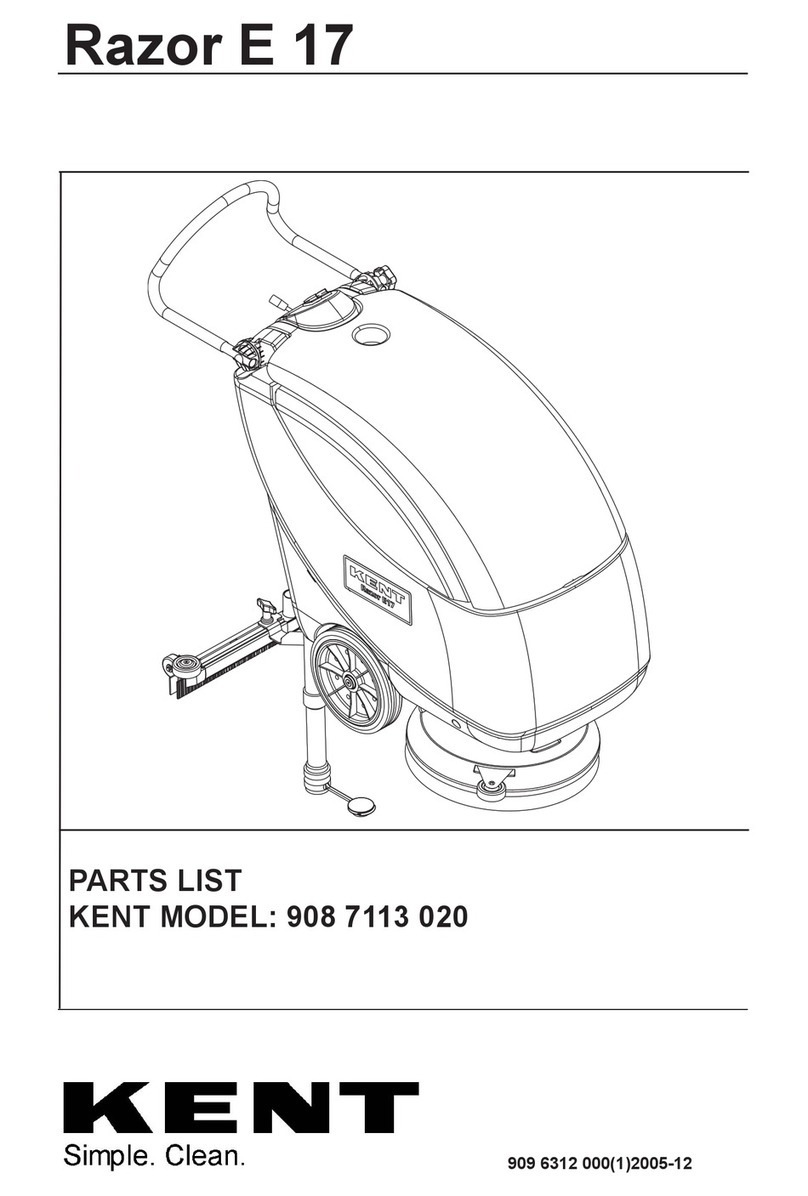
Kent Euroclean
Kent Euroclean Razor E 17 User manual
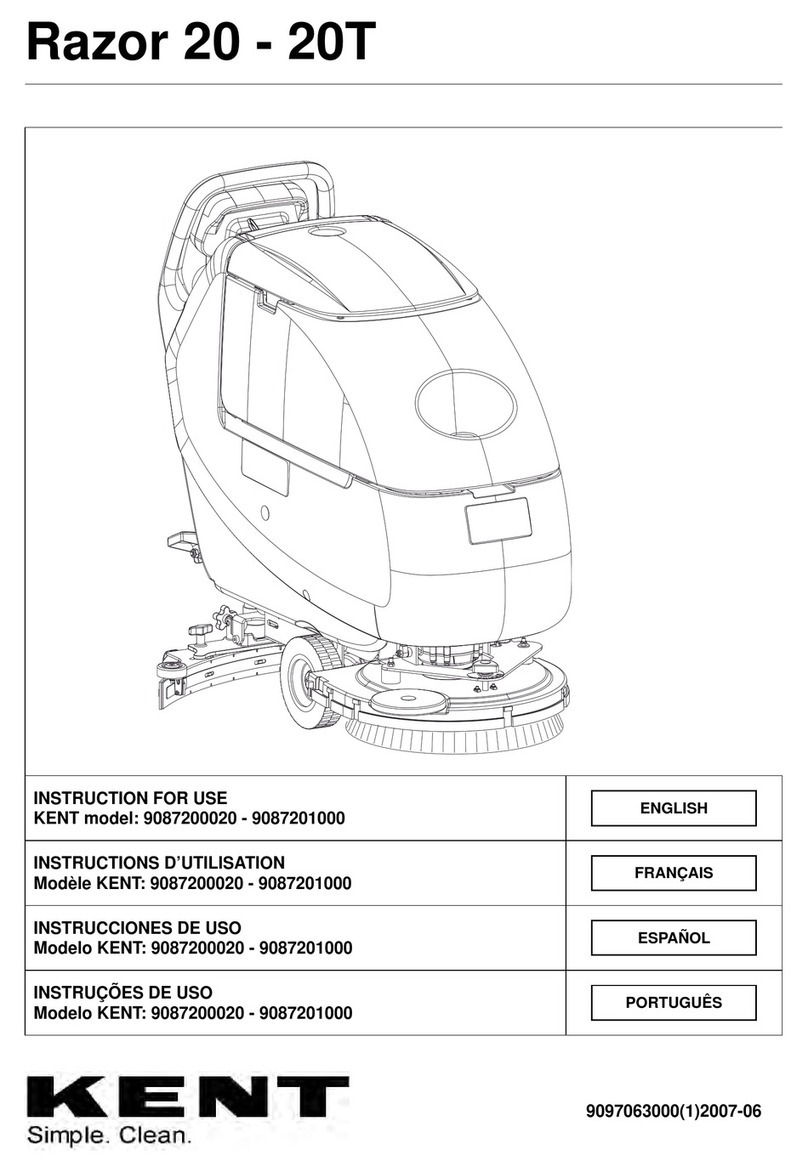
Kent Euroclean
Kent Euroclean 20 User manual
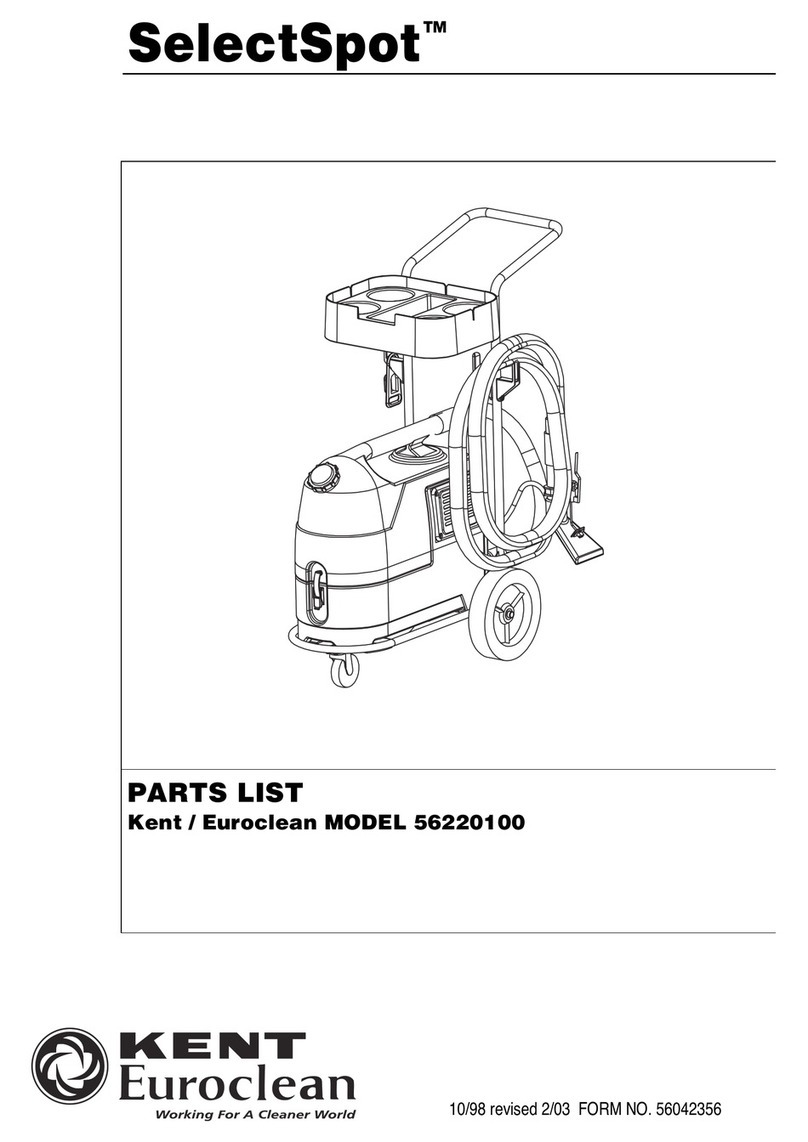
Kent Euroclean
Kent Euroclean SelectSpot User manual
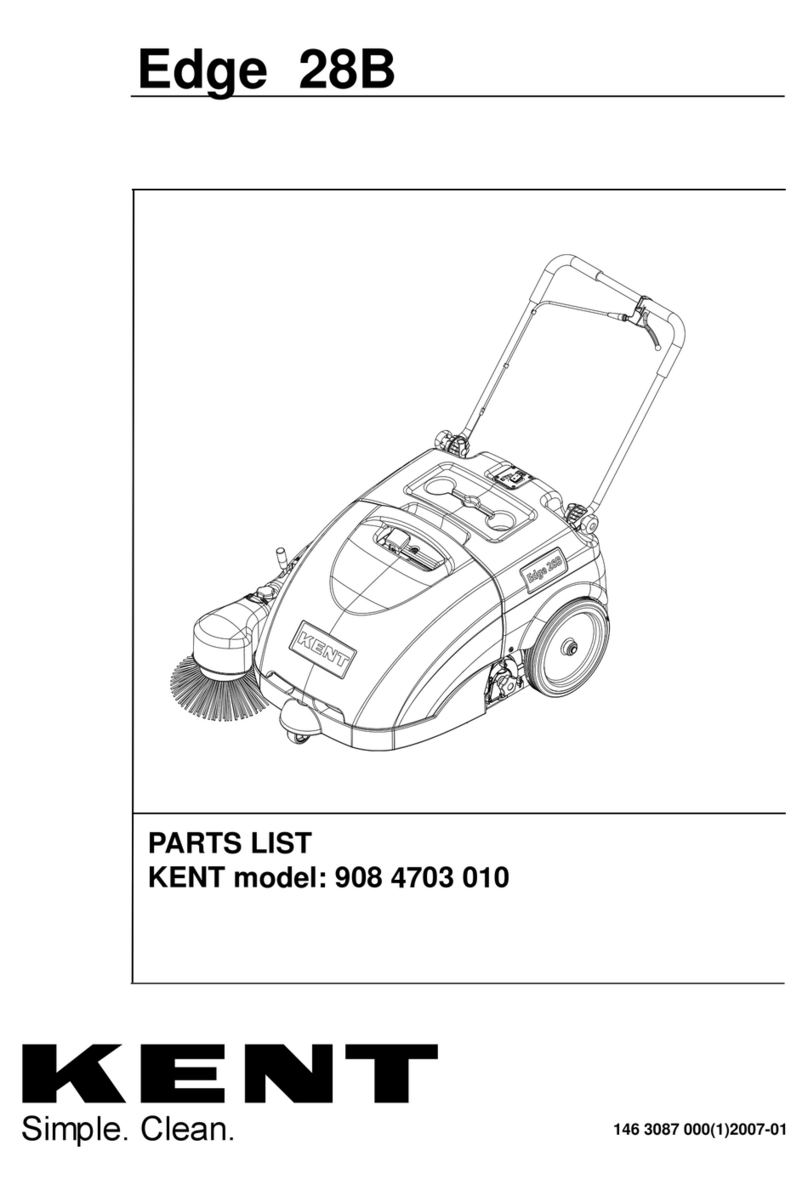
Kent Euroclean
Kent Euroclean Edge 28B User manual
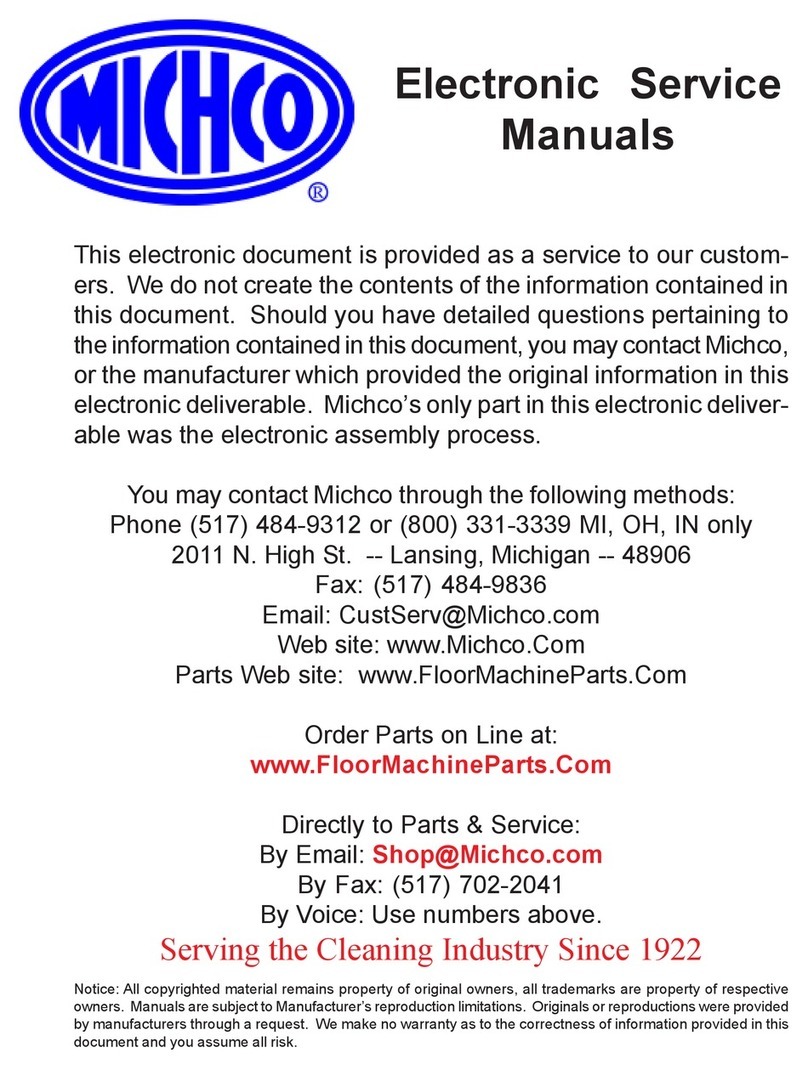
Kent Euroclean
Kent Euroclean Rainmaker C User manual
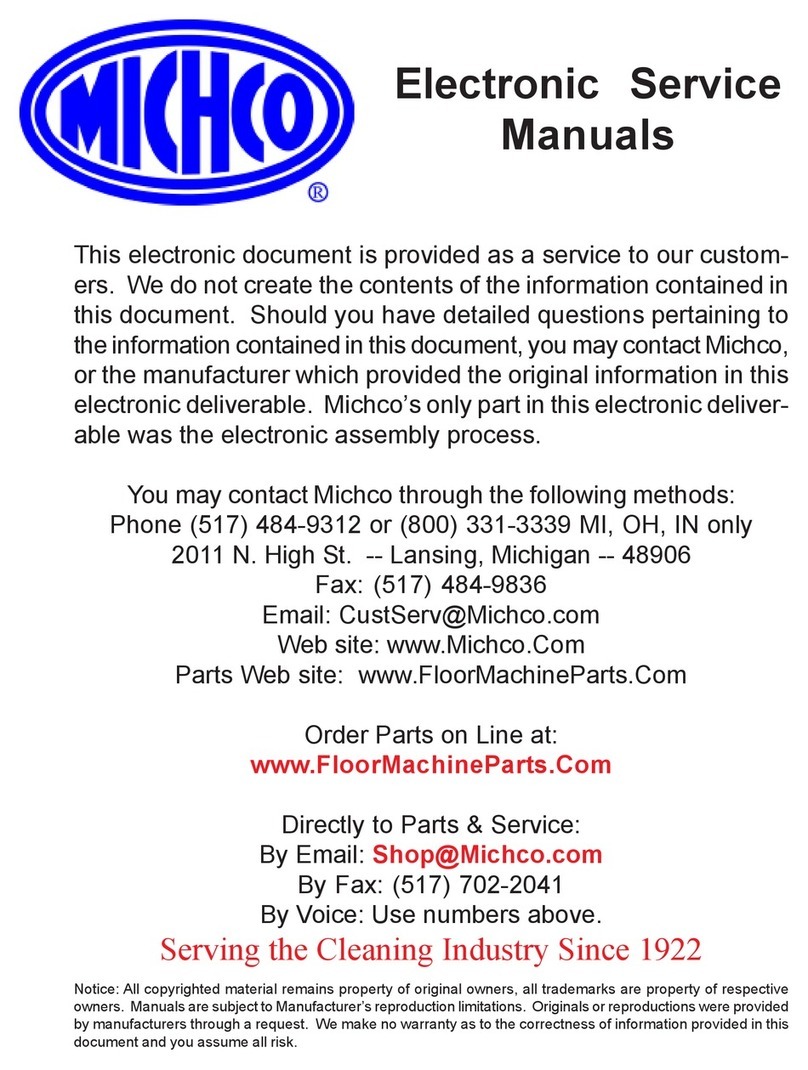
Kent Euroclean
Kent Euroclean SelectGloss 21PH Installation and maintenance instructions
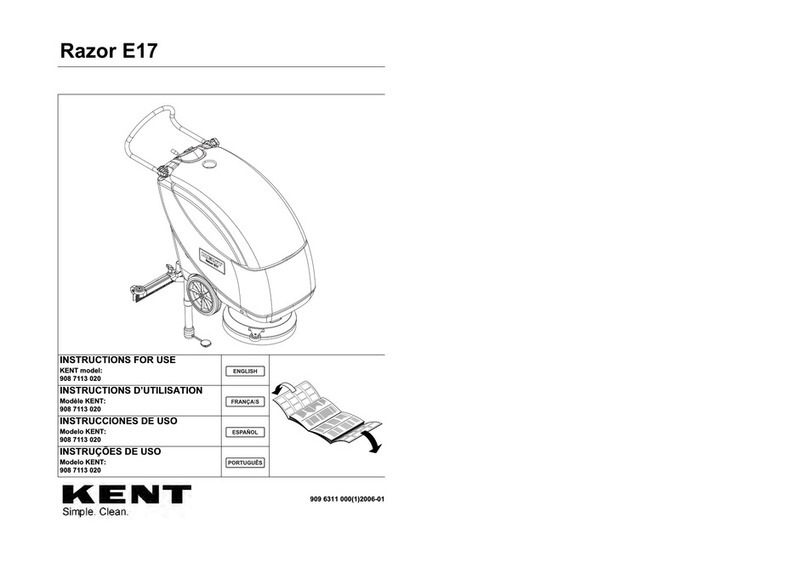
Kent Euroclean
Kent Euroclean Razor E 17 User manual
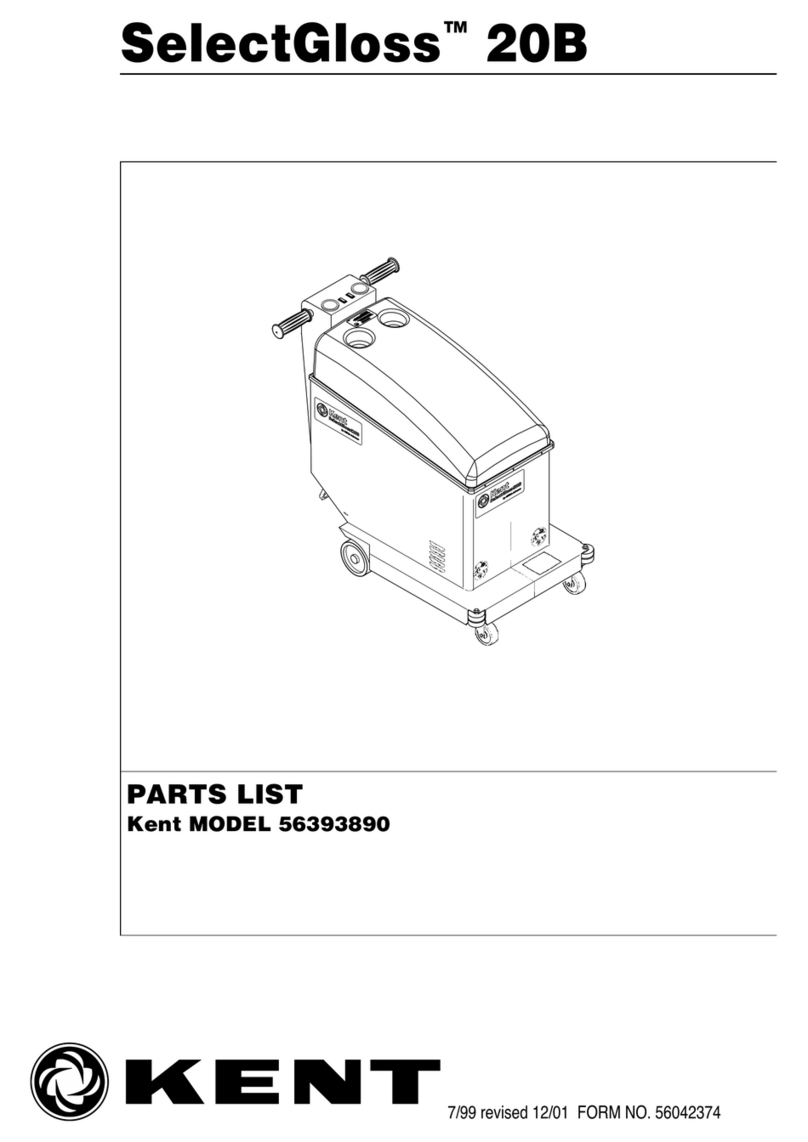
Kent Euroclean
Kent Euroclean SelectGloss 20B User manual
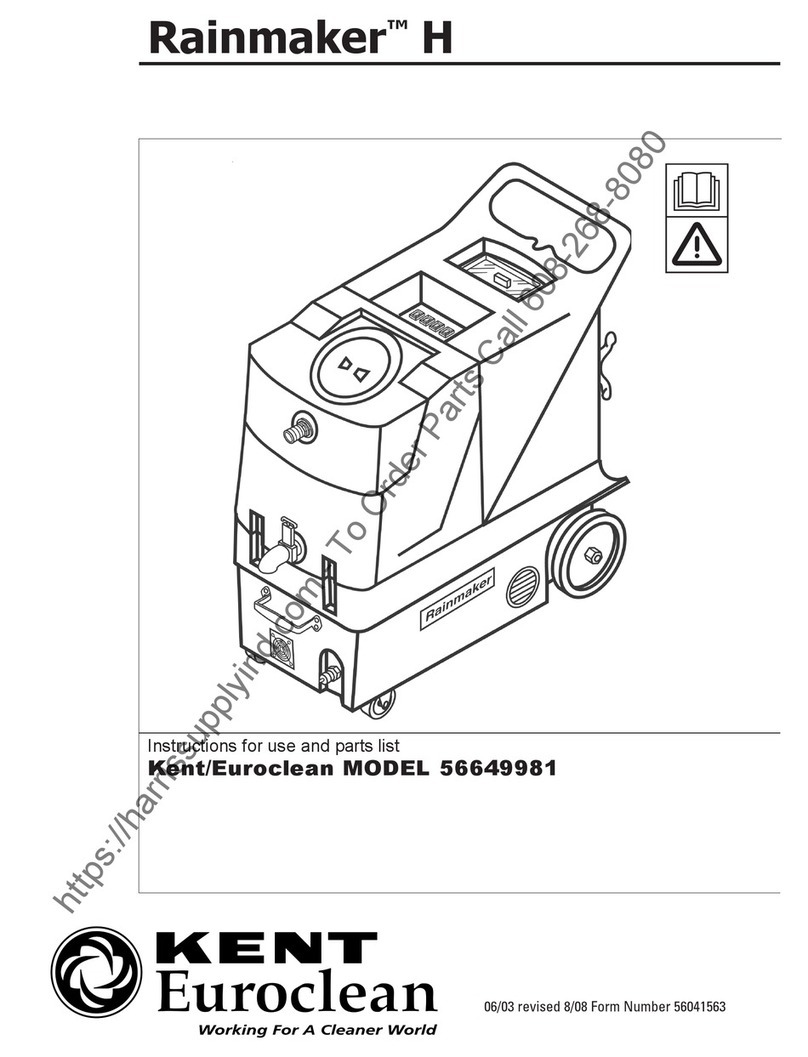
Kent Euroclean
Kent Euroclean 56649981 User manual
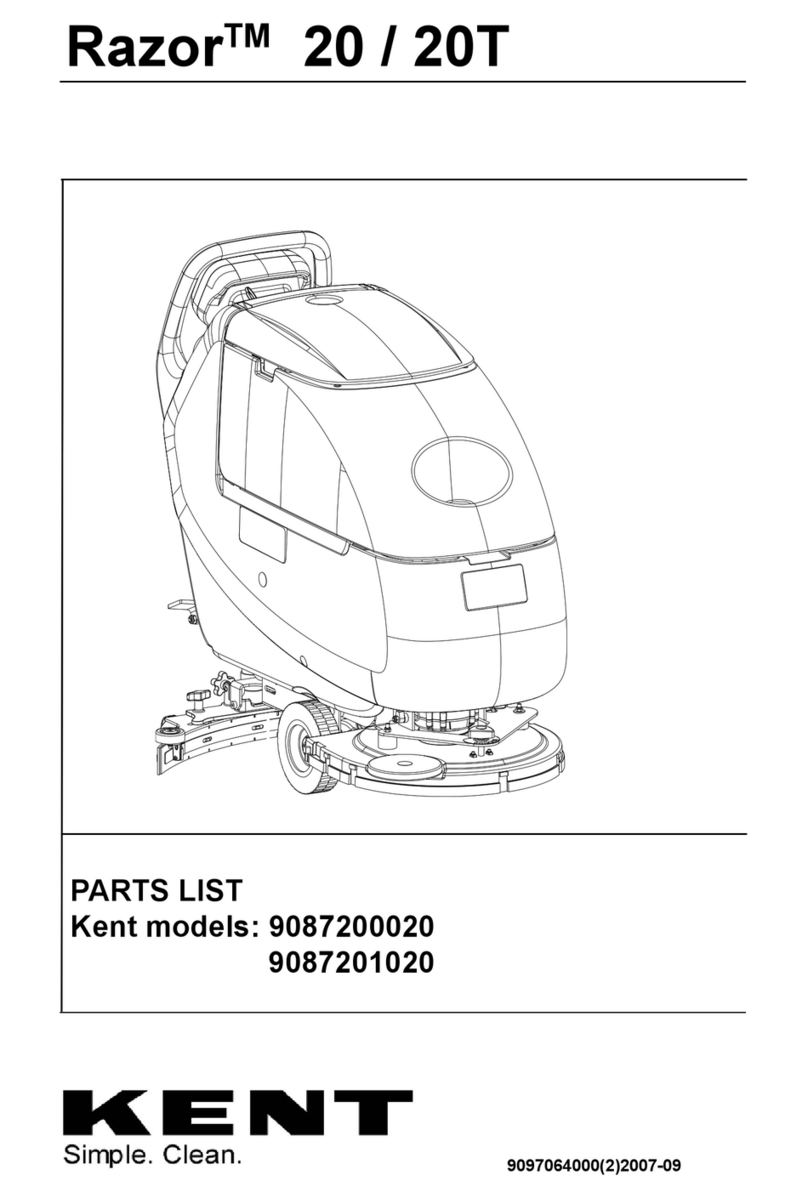
Kent Euroclean
Kent Euroclean 20 User manual


